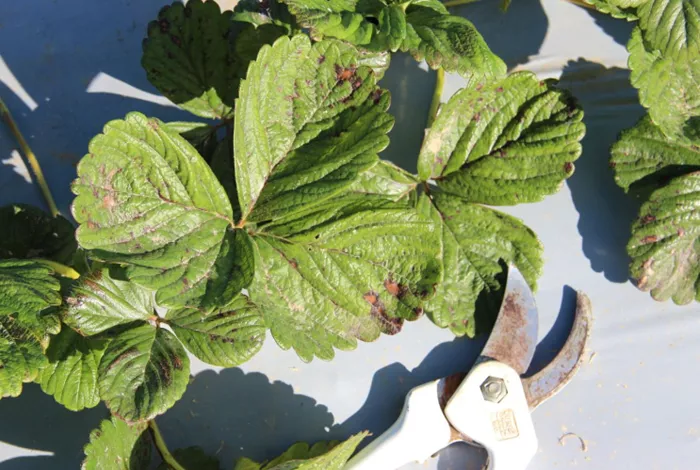Last month, I discussed potential issues with Neopestalotiopsis in strawberry plug plants. Fortunately, while this disease has appeared in Pennsylvania this fall, it does not seem to be as widespread as we initially feared.
However, strawberry growers have reported new foliar problems in their fields and have reached out to me and other Extension educators for guidance.
The recent warm and wet weather has created ideal conditions for powdery mildew, particularly affecting susceptible strawberry varieties. The Galletta variety has been notably impacted, and I also observed mildew on other varieties during a recent farm visit.
Identifying Powdery Mildew
Powdery mildew requires a living host to survive, typically overwintering on existing plants or being introduced through transplants. I suspect we may be inadvertently spreading powdery mildew through our transplants, similar to how we spread Neopestalotiopsis.
Powdery mildew thrives at temperatures between 60 and 80 degrees Fahrenheit and in moderate to high humidity. Once established, it can spread quickly in windy conditions. The same factors that promote foliar disease can also lead to fruit infections.
Symptoms of powdery mildew on strawberries can be subtle. Affected leaves may curl upward and develop reddish blotches near the edges. To identify the disease, you need to look closely for the characteristic white growth.
Powdery mildew-resistant varieties will show some leaf discoloration, but not as severe, and their leaves will not curl.
Fungicide Recommendations
Typically, we do not recommend fall fungicide applications for powdery mildew. However, due to the level of leaf damage observed, it may be wise to treat infected fields. Use fungicides from FRAC code 3, such as Procure or Rally. Inspire Super (3+9) is the recommended combination product. Other options include Gatten (U13), Torino (U6), and Quintec (13).
Avoid using products with FRAC code 11, as these should be reserved for controlling anthracnose crown and fruit rot in the spring.
Powdery mildew can survive in the crowns of plants, so be vigilant for infections in the spring, which can affect fruit and lead to harvest losses.
I advise against unnecessary fungicide applications this fall. Some growers have used copper products, but these can damage leaves in cooler weather. There have also been reports of crown rot diseases, such as Pythium, Phytophthora, and anthracnose, found in samples sent to the plant disease lab. These diseases can cause significant losses in wet conditions, but current findings are limited. Given the few fungicides available for crown rot diseases, only apply targeted fungicides when necessary, rather than using preventative sprays.
Be cautious if applying any foliar fertilizers. Damaging leaves now can negatively impact next year’s harvest.
Historically, we have not recommended fall fungicide applications. Recent concerns have prompted some growers to begin preventative treatments for their strawberry fields. I urge caution with this approach due to the risks of plant damage and fungicide resistance.
Related topics:
- Chrysanthemum Flowers Enter Harvest Time in Liupanshui, Southwest China
- Trees to Avoid Planting in Your Yard, According to an Arborist
- Smith’s Gardentown Presents a Series on Plant Care Tips


